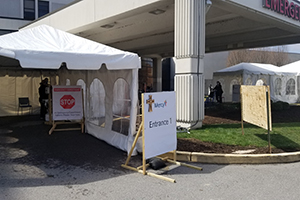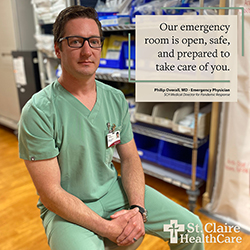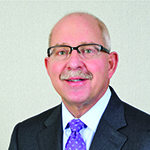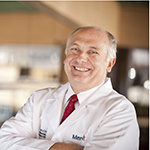By NANCY FOWLER
May 11, 2020
Close to one-third of Americans have put off emergency and routine medical care since the COVID-19 pandemic began, a trend illustrated by a dramatic drop in patients at some Catholic hospitals and outpatient facilities.
A survey released in late April by the American College of Emergency Physicians found that 29 percent of those polled are avoiding or postponing care. Seventy-three percent are concerned about contracting the coronavirus, and 59 percent are worried that they won't get treated even if they do go to a medical facility.

Mercy hospitals, like this one in suburban St. Louis, are using tents and temporary trailers to triage and separate patients with COVID-19 symptoms.
Delaying or avoiding care has resulted in treatable conditions becoming medical catastrophes, with some dying from ailments that might have been easily addressed through early intervention, according to physicians interviewed by Catholic Health World. Through press releases and social media, Catholic hospital systems are urging people not to wait. Doctors say those with chronic conditions like diabetes and hypertension should continue treatment, children should get their regular vaccinations and everyone should seek immediate medical attention for serious injuries, chest pain, breathing difficulties and other urgent concerns.
Hospital officials say they've ramped up precautions to protect people against COVID-19 exposure, stressing that patients are much more likely to suffer from delayed treatment than to contract the coronavirus in emergency rooms and doctors' offices.
"Waiting too long to seek medical attention could make the difference between life and death," Dr. William Jaquis, president of the organization of emergency physicians, said in a press release.
'We are prepared'
Since the pandemic began, St. Claire Regional Medical Center in Morehead, Kentucky, has seen a 40 to 50 percent drop in patients in its emergency room and doctors' offices. According to Dr. Philip Overall, medical director of emergency services at St. Claire HealthCare, people are cancelling standing appointments and letting their medications lapse. They're waiting too long to come to the emergency room with complications from hypertension and diabetes as well as traumatic injuries and infections, Overall said. Recently, a patient arrived with a large abscess.

St. Claire Regional Medical Center in Morehead, Kentucky, is urging community members to seek care in an emergency.
"I'm sure it started out small," Overall said. "But by the time the patient came into the emergency room, this abscess required emergency surgery."
St. Claire screens patients for COVID-19 symptoms including fever before they enter the ER waiting room; once inside, patients are screened again at registration. The ER waiting room has been partitioned off into separate areas for those with and without COVID-19 symptoms. This is to protect patients from contagion, especially those at high risk for coronavirus complications such as the elderly. Staff adhere to rigorous routines for hand washing and the use of personal protective equipment, he said.
"Our emergency department and waiting rooms are safe, and we are prepared to take care of anyone that walks in the door," Overall said.
Outbreak at meat plant raises fears
In Sioux Falls, South Dakota, an outbreak of COVID-19 at the Smithfield Foods pork processing plant may have been a factor in people staying away from the emergency room at the nearby Avera Heart Hospital, according to Dr. J. Michael Bacharach, who specializes in vascular medicine and intervention.

Bacharach
While Bacharach said he did not have specific numbers, he said it became evident that fewer people than usual were seeking emergency medical care even though the sparsely populated state did not implement stay-at-home orders. Some were scared off by news reports that nearly 800 employees of the plant had contracted COVID-19, Bacharach said.
"Suddenly, it hit home that this was not a disease unique to New York, New Jersey or California, but that it was here in the heartland," Bacharach said. "I think some people were afraid."
He said several patients waited two to three days after experiencing symptoms of a heart attack before seeking care. At least one patient died as a result.
"The overall message at this point in time is that if you have acute symptoms, do not be afraid to seek medical attention," Bacharach said. "Call us, let us know. Do not just stay at home and hope it's going to go away."
Patients coming back
In the early weeks of the pandemic, the number of emergency room patients at Mercy hospitals in Missouri, Arkansas, Kansas and Oklahoma fell by between 30 and 50 percent, according to Dr. Jeffrey Reames, vice president of emergency services. When patients did check in to emergency rooms, the lag in seeking care resulted in serious dehydration in patients with gastrointestinal illness, uncontained skin infections and serious respiratory distress in those with complications from chronic obstructive pulmonary disease.

Reames
In the past few weeks, Mercy has informed the public about its scaled-up safety measures including sequestering patients with COVID-19 symptoms in temporary trailers and behind emergency room barriers, emphasizing staff use of personal protective equipment and implementing additional disinfection procedures.
"The providers I work with say they wouldn't hesitate to bring their own family members to our emergency rooms," Reames said.
Mercy doctors' offices also saw as much as a 50 percent drop in patients initially. But in emergency rooms and medical offices, patient volumes are now back up to 75 to 80 percent of pre-pandemic levels, according to Michael Michetti, senior vice president and chief operating officer of Mercy Clinic, the St. Louis-based Mercy systems' physician group. The march toward normalcy is due in part to people coming back to physicians' offices. But it's mainly because more visits are taking place by phone or online.
Mercy offers a text-based monitoring system for outpatients with coronavirus symptoms or COVID-19. Every day, participating patients communicate with an emergency medical provider or internist, who help determine if they're getting better or worse and whether they need treatment.
Mercy, which has been building its telemedicine capacity for more than a decade to bring resources into rural communities, has transitioned 30-40% of its urban and suburban outpatient care during the pandemic to telehealth using video visit technology included within the EPIC electronic health record. Patients can schedule virtual visits themselves online, or a medical office may contact them and offer a video visit.
"Each office looks at the schedule for the next couple of weeks and is proactively reaching out and saying, 'Hey, I see you have an upcoming visit; it's just a check on how your medication is working so we can offer you a video visit if you prefer,'" Michetti said.
Primary care via video
A wide array of conditions lend themselves to at least an initial telehealth visit, according to Michetti. These include cough, cold and sinus infections, and even urinary tract infections and sprained limbs.
"A patient may say, 'It hurts when I put my arm up this high,'" Michetti said. "A provider can see and understand what's going on and start to talk it through to get the patient to the care they need."
Telehealth has been so successful that Mercy plans to continue the shift toward online appointments after the pandemic, Michetti said. He said the system was already planning to increase virtual care before the pandemic, before providers were forced to "hit the gas on this as hard as we could."
Patients who already had long-term relationships with their health care providers are the ones who've fared best through the pandemic, embracing telehealth as well as keeping up with any necessary in-person visits, Michetti said.
"That relationship has led to trust in the provider and in the system," Michetti said. "And on the provider side, it's the provider trusting the system and the structure to deliver care in new ways."